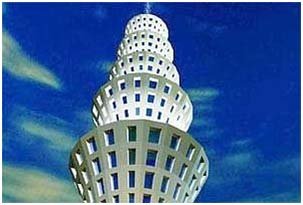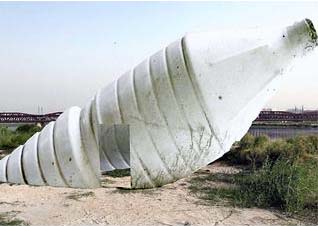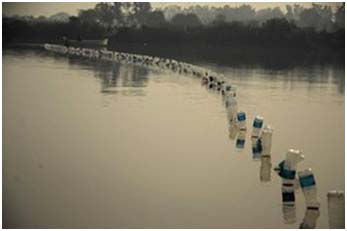Guest post by: Amita Bhaduri
The public art outreach project was organized by the Max Mueller Bhavan in association with the Government of Delhi and the Goethe-Institut (Hamburg, Germany) as a part of the “Year of Germany in India” programme opened on 5th of November, 2011. The art exhibition which continued till the 19th of November co-curated by artist Ravi Agarwal who is also a practicing environmentalist (Director, Toxics Link) along with German artist, Till Krauser attempted to create a pulsating synergy between the Yamuna and Elbe rivers.
 Gigi Scaria’s - The fountain of purification
Gigi Scaria’s - The fountain of purification
Photo courtesy: Rocky Thongam
This is a 24 ft installation representing a four storey apartment complex that draws Yamuna water, purifies it at various levels and dispenses it from the top in the form of a fountain.
The public art exhibition was held at the DDA Golden Jubilee Park near the historic Old Yamuna Bridge, the iron road and rail bridge, a piece of art in itself made by the British in 1866. Ironically the venue which also houses the Yamuna Biodiversity Park had just two years back seen the relocation of about four lakh slum dwellers that used to live here prior to the Commonwealth Games. This artistic project was centered on the idea of creating sustainable rivers in cities through on-site installations dealing with the ecological, developmental, socio-cultural and religious discourses around the rivers.
On display were the works of artists like Nana Petzet, Jochan Lampert and Clegg and Guttman from Germany, and Gigi Scaria and Atul Bhalla from India. The exhibition saw the artists reacting to the fact that “when you reduce nature down to its functional aspects, you lose the essential parts of what it’s all about” (Ravi Agarwal, 2011). Rivers in Europe have been engineered and shaped for the last 300 years to serve humanity.
While locating the project in specific discussions from within Delhi and Hamburg Ravi Agarwal, the curator was reported to have stated, “In Delhi, the Yamuna is being increasingly controlled as its riverbed is encroached on by urbanisation. It is believed that the Yamuna will one day be cleaned, like the Elbe, and that through progress, it will reach its 'ideal'. However, rivers in Europe are being 'un-engineered' and rethought of. The 'ideal' is a flawed idea, it seems now, and progress has not answered the question of ecology… In Delhi too, the idea is to bring people to the river itself as an experience. The river is caught constantly in a binary of 'polluted versus clean' discourse - whereas it is in fact a complex ecological landscape. Hence, the project is on the riverside itself here in order to bring people to the river. The idea is to create a discursive space of engagement and to think of the river as a socio-economic and natural landscape.” (Progress has not answered the question of ecology, Times of India, November 16, 2011)
Eco-friendly recyclable materials were used by the artists for creating the on-site installations along the Yamuna river, which despite being the main reason for Delhi’s location has almost been reduced to a drain these days. The river caters to seventy per cent of the city’s water demand and yet dumps about sixty per cent of the waste into it.

An image of Atul Bhalla's work installed in the public art festival
Photo courtesy: Shailaja Tripathi
Artist Atul Bhalla’s work was inspired from the “Yaksha Prashna” portion of Mahabharata where a series of questions and answers ensued between Yudhisthira and a lake. Small reed wells were made covered with twelve installations of around eighteen feet each comprising of giant plastic bottles embedded in the ground with pertinent questions like “What will be my defeat?” to sensitize people about the river and the city.
Artist Sheba Chhachhi’s work “Black waters will burn” was based on a fourteenth century hymn praising the river as beautiful. Through this she attempted to highlight the irony as to how people still worship the Yamuna as a goddess, but forget her material body. She used video projection and highlighted the text from Yamunastakam in praise of the river followed by an account of its fate.
 Asim Waqif's earlier work - Plastic bottles used as decorative light holders, lined up the Yamuna river
Asim Waqif's earlier work - Plastic bottles used as decorative light holders, lined up the Yamuna river
Photo courtesy: Project Y
Asim Waqif set up a “choreography of moving lights”, set to live percussion music every evening. The exhibition had an amphitheatre made of piles of gunny bags with soil from the riverbank with bamboo benches in which evening concerts were held by artists. Suchet Malhotra’s “Stories through sound” used wind instruments and percussion to create the story of Yamuna.
A series of cross-cultural events, including school debates, river walks, film shows, writing workshops were held at different venues to sensitize people to the riverfront and highlight it as a ecological entity which is under threat due to urbanization. Public discussions were held on the subject of impact of urban development on rivers to build awareness on the importance of river as an urban entity.
/articles/yamuna-elbe-public-art-and-outreach-project-yamuna-riverscape-delhi-launched-5-november